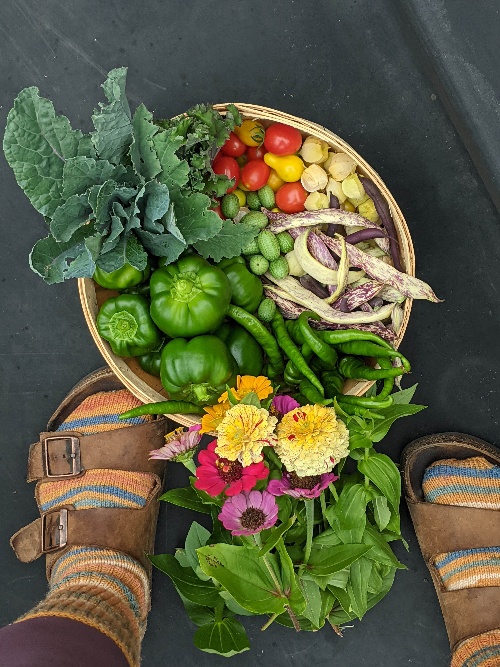
I want you to picture a beautiful cucumber, fresh from the garden – dark, emerald green skin, little pokey spines. You slice it open to reveal the cool jade interior. Hmm, there are a lot more seeds than you were expecting. Oh well. You take a bite and crinkle your nose. Bitter. Again.
For years, I ran into this problem no matter what variety I grew.
Tough skins, stabby spines, tons of seeds and bitter flavor or a deliciously mild, tender and crisp cucumber – it was always a crap shoot.
And then, one January, about three years ago, Baker Creek tucked a free packet of seeds into my order: Beit Alpha Cucumbers.
I had never heard of these things before. Eh, they can’t be any worse than the other varieties I’ve tried. I guess I’ll poke a few seeds in the ground this year and see what happens. So, I did.
Around the same time, I started noticing fancy little packages of “mini” cucumbers at Wegmans. They were wee and wrapped on cardboard trays, six in a row. I had no idea when these started showing up in grocery stores, but it felt like suddenly they were everywhere.
I had a dinner party planned and wanted veggies for crudité. In a rush, I grabbed a package of these ‘oh so fancy’ cukes.
I think I ate at least half of the cucumbers at the party. They were delicious. The skin was thin, they had very few seeds, absolutely no bitterness, and the flavor was wonderful – cool, light, refreshing.

That summer, I was surprised to find those same “mini” cucumbers growing in my garden – the Beit Alphas. I had stumbled upon cucumber perfection, aka the Persian cucumber, and it appears I’m not alone in my love of these crunchy, cool cukes.
Persian cucumbers are turning up in grocery stores, farmers’ markets, mezze platters and backyard gardens everywhere because they’re everything you want in a cucumber without all the things you don’t:
- Thin, tender skin—no peeling required.
- Virtually seedless, mild flavor, no bitterness.
- Their small size makes them perfect for raw eating and quick pickling.
- Satisfyingly crisp and crunchy without being watery or bland.
- Unlike slicing cucumbers and English cukes, Persian cukes are sweeter, firmer, and often more prolific.
- Many are parthenocarpic (having few or no seeds).
- What’s more, they’re so easy to grow.
Persian Cucumbers – a History

You know me, I love a bit of plant geekery. So, let’s take a look at the origin of Persian cucumbers.
Cucumis sativus trace their roots to the Middle East, particularly Iran, where they have been cultivated for centuries.
Traditional Persian cuisine features these cucumbers in dishes like mast-o-khiar (a yogurt and cucumber dip) and salad Shirazi (a cucumber, tomato, and onion salad), highlighting their cultural significance.
In the 20th century, efforts to improve cucumber varieties led to the development of the Beit Alpha cucumber in northern Israel. Breeders at the Beit Alpha kibbutz began in 1939 to cross local cucumbers with varieties from countries like India, Japan, and the United States, aiming to enhance disease resistance and flavor.
They certainly accomplished what they set out to do.
The resulting cultivar, known for its thin skin, crisp texture, and mild taste, gained popularity and became widely referred to as the Persian cucumber. You can read more about the history here and here.
“Mini Cucumbers”

You’ve probably eaten Persian cucumbers without even knowing it. They’re the darling of snackable cukes, slowly taking up more room in the produce aisle and edging out their larger, less flavorful cousins.
If you’ve bought a package of “baby” or “mini” cucumbers from the store, you’ve eaten Persian cucumbers. So, why not grow them in your garden this year?
Growing Persian Cucumbers
I’ve grown the Beit Alpha cucumbers exclusively for the last three years. I don’t think I’ll be growing any other kind of cukes in the near future. They did well during one of our dryer seasons without producing bitter cucumbers, and other than a year when I had squash borers wipe out all the cucurbits in my garden, they’re quite hardy.
I’ve been impressed with how quickly they start producing and how productive they are. I grow my cucumbers vertically, so it’s easier to see and pick them when they’re ready.
Start Indoors or Direct Sow?
I’ve done both in the same season when I decided I wanted a couple of extra plants for more pickles. (I’m in zone 6b if that helps.) The ones that were direct sown started producing fruit about three weeks after the transplanted seedlings.
If you live in a hardiness zone with a shorter growing season, you may want to start your cucumbers early indoors. However, it’s important not to start them too early. You can read about the issues that come with that here.
Vertical or on the Ground
As I already mentioned, I grow my cucurbits vertically. In my garden, if it climbs, it’s grown up a string or trellis. Growing vertically allows me to maximize my gardening space and often means I can plant more of the same thing, cucumbers, for instance, to get a higher yield without taking up more space.
I’ve also found that growing vertically, I have fewer issues with diseases. The plants aren’t lying on the ground, and they have much better airflow around them.
Planting & Harvesting

Sow or plant outside after all danger of frost has passed.
Soil: Like all cucumbers, Persian cucumbers prefer rich, loamy, well-draining soil. Mix in some compost or worm castings before you sow the seeds, or add it to the hole before planting seedlings. If you’re planting seedlings, water them in immediately and aim to plant on a cloudy day to allow them to recover.
Sun requirements: As a fruit-bearing plant, Persian cucumbers require between 6-8 hours of full sun a day. The longer they’re in the sun, the more fruit you will get.
Water requirements: These need consistent moisture to produce lovely, fresh cucumbers. Water deeply if the top inch of the soil is dry. You’ll have happier plants if you mulch around the base. Adding a 3-4” layer of mulch suppresses weeds, holds moisture and helps to keep the soil cool during the hottest parts of the summer, which can otherwise slow down fruit production.
Harvest: Pick the cucumbers when they are 4-6 inches long. Check the plant frequently and pick often to encourage more fruit.
Popular Persian Cucumber Varieties

Mandy Beit Alpha
Description: A classic Middle Eastern variety known for its thin skin, crisp texture, and sweet flavor. Parthenocarpic and gynecious, making it highly productive even in challenging conditions.
Green Fingers
Description: A compact, prolific variety ideal for container gardening. Produces slender, crisp cucumbers perfect for snacking.
Muncher
Description: A tender, burpless slicing cucumber with smooth skin and a crisp bite. High-yielding and ready to pick at 5” long. Resistant to several common cucumber diseases.
Super Zagross
Description: Open-pollinated. Thin-skinned, cool, and mild. Pick often to encourage more cucumbers. Great for succession plantings.
Give these fabulous little cukes a try this year, even if you only grow one or two plants. I’ll bet you’ll be making room for more in your garden in the future.

Get the famous Rural Sprout newsletter delivered to your inbox.
Join the 50,000+ gardeners who get timely gardening tutorials, tips and tasks delivered direct to their inbox.

